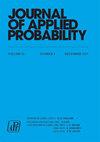${\mathbb{Z}}上懒惰青蛙的共存$
IF 0.7
4区 数学
Q3 STATISTICS & PROBABILITY
引用次数: 0
摘要
摘要我们研究了${\mathbb{Z}}$上的所谓青蛙模型,其中有两种类型的懒惰青蛙,参数分别为$p1,p_2\in(0,1]$,每个地点的休眠青蛙数量有限。这回答了Deijfen、Hirscher和Lopes在维度一中的一个问题。本文章由计算机程序翻译,如有差异,请以英文原文为准。
Coexistence of lazy frogs on
${\mathbb{Z}}$
Abstract We study the so-called frog model on
${\mathbb{Z}}$
with two types of lazy frogs, with parameters
$p_1,p_2\in (0,1]$
respectively, and a finite expected number of dormant frogs per site. We show that for any such
$p_1$
and
$p_2$
there is positive probability that the two types coexist (i.e. that both types activate infinitely many frogs). This answers a question of Deijfen, Hirscher, and Lopes in dimension one.
求助全文
通过发布文献求助,成功后即可免费获取论文全文。
去求助
来源期刊

Journal of Applied Probability
数学-统计学与概率论
CiteScore
1.50
自引率
10.00%
发文量
92
审稿时长
6-12 weeks
期刊介绍:
Journal of Applied Probability is the oldest journal devoted to the publication of research in the field of applied probability. It is an international journal published by the Applied Probability Trust, and it serves as a companion publication to the Advances in Applied Probability. Its wide audience includes leading researchers across the entire spectrum of applied probability, including biosciences applications, operations research, telecommunications, computer science, engineering, epidemiology, financial mathematics, the physical and social sciences, and any field where stochastic modeling is used.
A submission to Applied Probability represents a submission that may, at the Editor-in-Chief’s discretion, appear in either the Journal of Applied Probability or the Advances in Applied Probability. Typically, shorter papers appear in the Journal, with longer contributions appearing in the Advances.
 求助内容:
求助内容: 应助结果提醒方式:
应助结果提醒方式:


